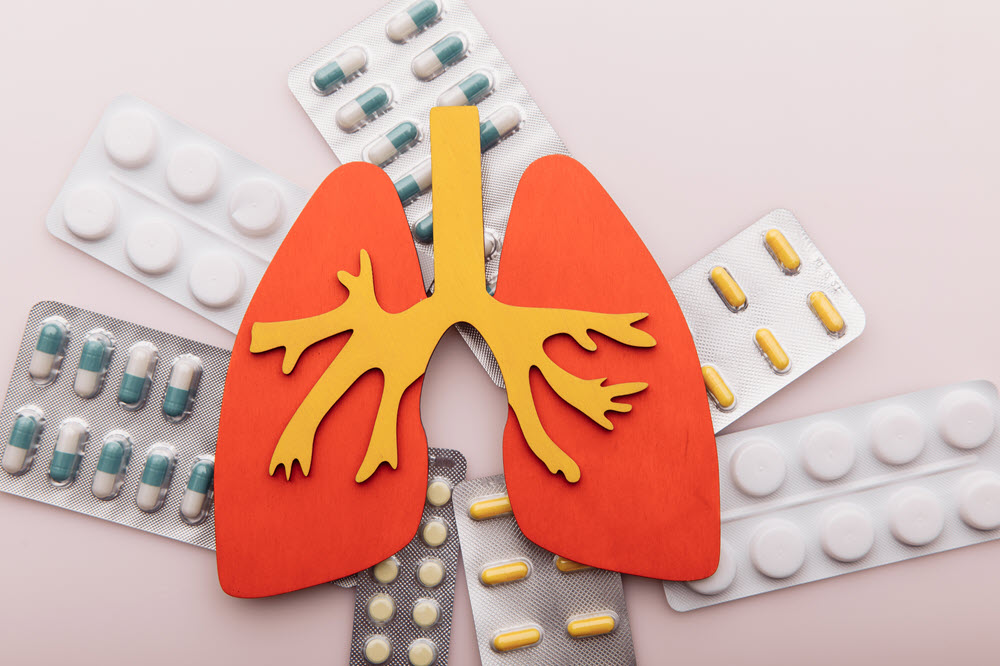Allergies & Immunology
Idiopathic Pulmonary Fibrosis (IPF): Symptoms, Causes, and Treatment
By S.I. (staff writer) , published on August 20, 2021

Medicine Telehealth Health lungs respiration
What is Idiopathic Pulmonary Fibrosis (IPF)?
The word ‘idiopathic’ means ‘of unknown cause.’ This type of pulmonary fibrosis is caused by unknown reasons. IPF is characterized by the stiffening of the lung tissues owing to unidentified reasons. Stiffening of the lungs makes it difficult for the lung tissues to extend when you take in air. This makes the natural breathing process harder [1].
It is a serious disease that needs to be treated as soon as possible to improve the breathing capacity of your lungs. This condition can worsen over time if not diagnosed and treated.
What are the Symptoms of IPF?
IPF causes stiffening and scarring of the lungs, decreasing the lung capacity. Following are the most common symptoms of IPF [2]:
- Chronic cough
- Weakness
- Weight loss
- Fatigue and tiredness
- Chest discomfort
- Shortness of breath
- Swollen legs
- Clubbing of figure
- Bodyache
- Edema
- Loss of appetite
- Disturbed sleep
What Causes IPF?
It is a multifactorial disease. IPF can be attributed to many different causes. Some common causes and risk factors of IPF are listed below [3]:
- Pollution
- Infections
- Gastric acid reflux disease (GERD)
- Toxins
- Genetic factors
- Medications
- Smoking
- Environmental factors
- Existing conditions
- Advancing age
However, in most cases, the cause of IPF cannot be specified. The disease is then referred to as ‘idiopathic’.
Once the disease is diagnosed, treatment should be started as soon as possible to prevent the worsening of the condition.
What are the Treatment Options for IPF?
Unfortunately, Idiopathic pulmonary fibrosis cannot be cured. However, several treatment options are available that can help manage and reduce the symptoms of IPF. Treatment can reduce inflammation, scarring, and fibrosis, leading to improved pulmonary capacity. Following are the common treatment options [4]:
- Medications: common medicines prescribed for IPF are pirfenidone and nintedanib. to slow lung stiffening and scaring, preventing further damage to the lungs. Apart from these, corticosteroids reduce inflammation and increase lung capacity.
- Oxygen therapy: oxygen demand depends upon the condition of your lungs. Some people need oxygen therapy 24/7 while others need it after a hectic day or exercise.
- Pulmonary rehabilitation: for pulmonary rehab, you need to work with a team of doctors, therapists, and nurses. You are given a healthy schedule to follow. A healthy diet, proper breathing exercises, relaxation techniques, and stress relief can improve your condition.
- Lung transplant: it is the last option if all the other options fail to alleviate the symptoms. It is a major surgery that is only recommended if your lungs are completely out of order. Finding a suitable donor can take some time [5]. After a suitable donor is found, your surgery is planned. You might need to stay in the hospital for 3 or more days after the surgery. You are kept under observation to prevent transplant rejection. Routine tests are carried out to keep an eye on the functioning of the lungs. If everything goes well, you are discharged after some days.
References:
- https://www.ncbi.nlm.nih.gov/books/NBK448162/#:~:text=Idiopathic%20pulmonary%20fibrosis%20(IPF)%20is,dyspnea%20and%20a%20nonproductive%20cough.
- https://www.ncbi.nlm.nih.gov/books/NBK448162/#:~:text=The%20most%20common%20presenting%20symptoms,must%20be%20excluded%20before%20diagnosis.
- https://www.ncbi.nlm.nih.gov/books/NBK448162/#:~:text=Environmental%20factors%20like%20smoking%2C%20chronic,for%20the%20pathogenesis%20of%20IPF.
- https://www.ncbi.nlm.nih.gov/books/NBK448162/
5. https://www.ncbi.nlm.nih.gov/books/NBK565849/
Find articles related to: Medicine Telehealth Health lungs respiration
More articles about Allergies & Immunology
Back to the Health Tips Index




